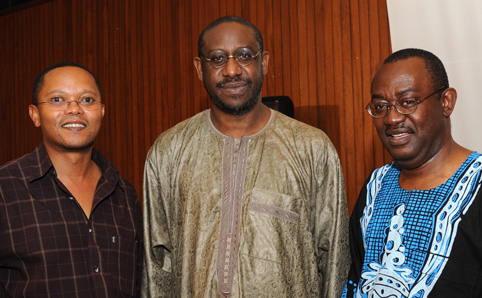|

|
|
Making their mark at the ANC Centenary Dialogue were, from left to right: Prof. Kwandiwe Kondlo, Senior Professor: Centre for Africa Studies (UFS); Dr Adekeye Adebajo, Director: Centre for Conflict Resolution (Cape Town); and Prof. E C Ejiogu, Senior Researcher: Centre for Africa Studies (UFS).
|
The Centre for Africa Studies at our university recently hosted its ANC Centenary Dialogue at the Bloemfontein Campus. Keynote speaker, Dr Adekeye Adebajo, delivered a paper titled Nelson Mandela, Thabo Mbeki, and the ANC’s Footprint in Africa. The lecture focused on two of South Africa’s democratically-elected presidents.
Mr Nelson Mandela was South Africa’s first democratically-elected president. This Nobel Peace Laureate played a prophetic leadership role in Africa in 1993. He was inspired by Mr Mahatma Gandhi’s tactics of ‘passive resistance’, which played a role in the ANC’s Defiance Campaign.
Mr Mandela’s visit to other African countries gave him insights into continental diplomacy and the tactics of other liberation movements. “The ANC used Madiba to embody the face of the struggle. He emerged from prison without any bitterness towards his enemies. He tirelessly promoted national reconciliation,” said Dr Adebajo.
Unlike other post-independence ‘Founding Fathers’, Mr Mandela bowed out gracefully at the end of his first presidential term in 1999, setting a standard for future African leaders aspiring to greatness. “Mr Mandela’s lasting legacies are his efforts at promoting national and international peacemaking,” elaborated Dr Adebajo.
Mr Thabo Mbeki challenged Africans to discover a sense of their own self-confidence after centuries of slavery and colonialism. Under his foreign policy, South Africa established solid credentials to become Africa’s leading power. He sought multilateral solutions to resolve regional conflicts. Mr Mbeki also sent peacekeepers abroad and increased South Africa’s credibility as a major geostrategic player in Africa.
Many question whether Mr Mbeki’s heirs, President Jacob Zuma and beyond, will maintain the same level of commitment to the continent that he demonstrated. Mr Mbeki has bequeathed this foreign policy legacy to his successors. “These very different ANC leaders have left a heavy African footprint on the sands of time,” concluded Dr Adebajo.